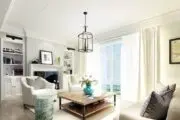A new home is a blank canvas with tons of opportunity, but trying to visualize design elements and décor choices and how they intermingle to create an overall aesthetic is challenging.
Gathering inspiration from social media, watching home design shows and getting physical samples of materials and colors is a start, but there still lingers the possibility of regret, because a big part of the selection puzzle is missing, namely around size, scale, comfort and true color.
Augmented reality (AR) addresses that challenge by providing authentic visual context. It’s being used widely in the interior design industry to help consumers have a more comprehensive idea of what a space will look like.
How AR works in interior design
Interior designers and retailers see AR technology as a way of helping to communicate concepts to homeowners, framing expectations and building homeowner confidence in their design and décor decisions.
In this new era of design, homeowners are “much more educated,” says interior designer, Autumn Pochiro. This level of consumer engagement requires more tools, which is where AI, AR in particular, comes in.
AR in interior design functions by layering virtual versions of design or décor choices in a designated space, either with an uploaded photo, or with a video feed. It’s not a perfect science, especially when it comes to items that are tactile, such as furniture, or with color choices that may vary with absence and presence of natural light in the physical world, but it is a reasonably accurate way to support the decision-making process for homeowners.
Homeowners, “want to be greener and are looking more closely at details,” such as fabrics and materials, says Pochiro.
Homeowners “spend their money differently. When people do hire designers, they expect a lot from us. And I think it’s important that we deliver that,” says Pochiro, which is in part why AR and AI are growing so quickly as tools in interior design to bridge the transition from inspiration towards practicality.
Generative AI, such as Midjourney, helps to spark inspiration, but AR contextualizes visuals and often provides homeowners with the opportunity to before they buy, virtually, to ensure the right fit, aesthetically and physically.
For interior designers, the flexibility that AR provides allows them to experiment with different materials, colors and ideas to effectively demonstrate concepts to homeowners.
AR is also widening options for homeowners. “In physical design, designers only use materials we can source. Now we can design custom items, integrate each piece into the design, and monetize the items,” says Pochiro.
It opens homeowners’ eyes to the possibilities. AR is “helpful because homeowners can choose each piece of the design if the company they are using has formatted to import images. For instance, companies such as Kohler and Cambria import this technology when we draw the 3D image in Chief Architect,” says Pochiro. Chief Architect is a popular home design 3D software, widely used in the design community.
“Clients can view their actual model in real-time with augmented reality AI that walks them through their space,” says Pochiro.
AR to facilitate purchase decisions
Trying to pick the “right” accent or piece can be challenging in an online environment, because of difficulty perceiving size, scale and color.
Similarly, homeowners who venture into a bricks-and-mortar store to view design and décor items may find that a piece looks great styled in the showroom but isn’t suitable for their space at home. Or a counter or paint sample is too small to get a full understanding of what a selection would look like spread out in a whole room.
There are several apps and AR software available that are quick and easy to help homeowners make smart choices for their homes.
Cambria has an AR app from which a homeowner scans their space with their smartphone, with horizontal and vertical options, to help select counters and backsplash. Homeowners mark the corners of the space (so that the app can determine size) and instantly they can load several designs, colors and materials, with ability to do slight, nuanced variations, compare selections and even visualize around cutouts (such as appliances and plumbing fixtures). Selections are easily shareable, handy when working with a designer or builder.
IKEA Place is an app that lets homeowners see what furniture selections would look like at home. The app automatically scales furniture with detailed accuracy, based on room dimensions. The tech even considers fabric and variations in color, based on shadows present in the room.
Other big retailers and manufacturers such as Wayfair, Houzz and Kohler have similar options, using AR technology to help homeowners accurately visualize items they hope to have to furnish, decorate or build their homes. Many have embedded links to products to help facilitate purchase.
AR mitigates buyer regret
Being able to have a more accurate visual representative for the consumer has considerable upside, including making better informed decisions to mitigate buyer regret.
It’s also convenient, explains Giedrius Morkunas, founder of DressMyCrib, an AR-powered marketplace for rugs. DressMyCrib carries an extensive catalogue of rugs from numerous vendors, all of which get converted to AR. Shoppers can upload photos of their rooms and browse from rugs in the AR marketplace.
“AR saves time. You can browse the web from your home to find home décor items you like. Once you find one, you can transform it to AR format and see how it could look in your home,” says Morkunas.
It can also unlock creativity. “You can upload an image of your room and place any AR item directly on that image, playing as much as you want,” says Morkunas.
There are also environmental and cost benefits, as there is a relatively high return rate with housing décor goods and furniture.
“On average, customers return 30 percent of their online furnishing purchases and 9 percent of items bought from brick-and-mortar stores. With the ability to see the product at home before they purchase, AR helps to reduce the number of product returns,” says Morkunas.
With greater confidence in the purchase, shoppers (and shipping companies) don’t have to use extra fuel or spend money to return items after they are received at home and determined to be unsuitable.








